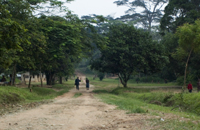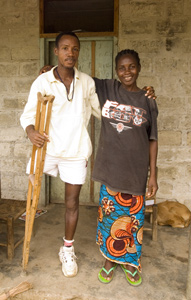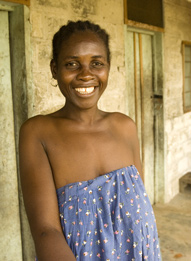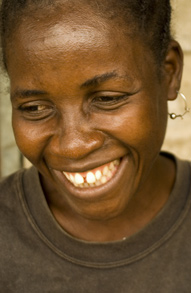dry.

Yamah gave birth at the wrong time. The place wasn't ideal either, a West African nation tangled in a brutal civil war, but the timing, late 1994, was just plain awful. Just after Yamah went into labor, rebels stormed into the village of Gbarnga, Liberia, sending the town's inhabitants scurrying to safety in the bush. Among them were the midwives, and Yamah spent four days in intense pain searching for someone to help deliver her baby. Finally, old lady Kpeh was located, and a delivery that began at six a.m. finished twelve hours later.
She gave birth to a stillborn child and Yamah began leaking urine through her birth canal. She developed a condition called vesicovaginal fistula or "VVF" as it's known among doctors. During delivery, the extended pressure of the baby's head against her pelvis left a hole in the tissue between the bladder and the birth canal.
Although unheard of in developed nations for almost a century (the last fistula hospital in the US closed near the end of the 19th century), because of where she was born, Yamah is not alone with this condition. The United Nations estimates two million women in Africa and Asia suffer from this condition, many of them constantly leaking feces as well.
So Yamah did what most would do. She sought a doctor. During war this wasn't easy, and she was told simply by the ones she found that her problem was "too heavy." It's hard to imagine, but because of her incontinence, Yamah smelled of urine. All the time. She would avoid people, staying mainly inside her house, but when she did come in contact with them, she said they would give her dirty looks and "talk bad about her."
In 1998, during a lull in the war, she met Sam. Sam had returned to Liberia from Guinea where he had fled to escape the fighting, and sought treatment for his leprosy at the Ganta Rehab Center. He came with a badly ulcerated leg that was later to be amputated and replaced with a crutch. Although cured now, Sam has dark, sorrowful eyes and bears the scars of leprosy in his face.
He tells me he met Yamah when she ventured out to buy something.
"I asked her to be my friend," Sam says. "She told me her problem. I said okay, we will see about it."
The next few years were difficult but Sam says he stayed with her. "I used to sometimes comfort her that God one day might make her better. I made up my mind for she and myself to be together."

A fine pair of misfits they were, Sam, hobbling along on one leg, making and selling straw baskets for about $8 each, saving money. Yamah, hiding in the house, unable to shake a constant stench of urine.
Hope came in the form of a visiting surgeon at local hospital, a sleepy facility founded by an American missionary in the 1920's. It is one of only three places in the country where it is possible to have a fistula surgery - when a qualified surgeon is present. But most women can only dream of obtaining the $150 it costs for the procedure.
Luckily for Yamah, Sam the leper had somehow saved enough money for the operation. She was admitted to hospital in November of 2000 and scheduled for surgery. Six years after she began leaking.
The operation is a tricky one, and requires great skill on the part of the surgeon. Many patients are determined unfixable after an initial examination yet fortunately, this wasn't the case for Yamah. Her operation seemed a success at its completion, Sam tells me, until a nurse, while removing the catheter, just "pull it."
It's gruesome to hear him describe it, "The blood started coming," he says. Hope yanked away and replaced with fear, more urine, and this time intense pain.
As the surgeon was leaving the next day to accept a scholarship in the United States, Sam and Yamah were told sorry, nothing can be done.
Another three years of suffering passed before Sam heard on the radio that a ship was coming to Liberia that provided free surgery - fistula fixes among the procedures performed.
At the screening date in early March, Mercy Ships doctors examined Yamah, and Sam says he just sat outside praying. "This is the last chance," he says he thought. "If people come from another country and they fail, how are we gonna manage now." Sam says while waiting, he saw another woman with a VVF rejected for surgery, her tear deemed irreparable. "I said, oh... what if this happen to my wife too."
Yamah was examined by Scottish surgeon Dr. Fiona Burslem and scheduled for surgery. Although it is uncommon that surgeons will attempt to "fix" other surgeons failed operations, Dr. Burslem thought she could repair Yamah. She scheduled her for surgery on March 30.
Sam says they left early and traveled across the country to Monrovia, where the ship is docked. They arrived on March 28.
"I was so excited, I met security. They said not to enter yet. I started appealing. Economic reasons first. I said please find somebody to talk to. I saw Betty (a nurse on the ship). When she came, I explain I want to be on time. She went and checked, she found an empty bed."
Yamah said when she saw the ship, she felt peace. It was her first time to Monrovia, her first time seeing a ship. "I was not scared," she said. "I knew my problem would be solved. I was praying, every morning, every evening."
Late in the afternoon of March 30th, after the surgical procedure, Yamah woke up in the ship's hospital ward, dry for the first time in 11 years.
* * *
Yamah has a lovely smile and shy, girlish giggle that now seem ever present. She thinks she's about 30 years old now, but looks younger. We talked as she scrubbed clothes on the doorstep of the small stone house where she lives with Sam on the fringe of the Rehab leprosy compound. Chickens and small dogs sometimes interrupted and were chased away by a brandished broomstick.
She has been transformed. She has made new friends, she can go out among people without fearing their looks of scorn and disgust. She can go to church without spoiling her clothes.
"My heart is all right. I feel free," she says simply.


----------------------------------------------
GET THE PDF OF THIS STORY HERE.
To watch a five minute video of Mercy Ships's work and learn more about VVF surgery, please visit http://www.onamercyship.com/video.html
If you're interested in sponsoring a surgery or supporting the work of mercy ships, write me here: scott@onamercyship.com
please visit www.onamercyship.com
for more images and words, including the latest pics from five days in the leper colony here.



